Do you want to build a website but don’t find WordPress to your liking? No problem! In this article, we will cover 10 of the best alternatives for WordPress ranging from content management systems (CMS) and website builders to ecommerce and blogging platforms.
Take a look at our review on each platform’s features as well as the pros and cons and see if you can find the one best suited to your needs.
Why WordPress Isn’t for Everyone
WordPress became one of the best and most popular CMS platforms for a good reason. Aside from accommodating the website building process for a wide range of users with different needs and levels technical knowledge, it also has a ton of great themes and plugins to expand site functionality and spice up appearance.
Despite this, WordPress has its limitations. To use third-party plugins and themes with WordPress.com, you need to upgrade to the Business plan. While WordPress.org provides more freedom in this matter, it does require some technical knowledge to set up and maintain.
Bottom line, WordPress isn’t a one-size-fits-all platform. While the basic features are enough to build a standard website, you need to learn about WordPress to fully utilize its potential. Understandably, not everyone has the time to do it.
For this reason, it’s often a good idea to see what other alternative platforms are in store. Similar to WordPress, each platform has its strengths and specialties that make it stand out from the competition. Thus, different users will have a different preference depending on their needs.
Top 10 WordPress Alternatives Worth Checking
To save your time, we took the liberty of gathering up 10 of the best WordPress alternatives capable of assisting you in building a website:
1. Drupal
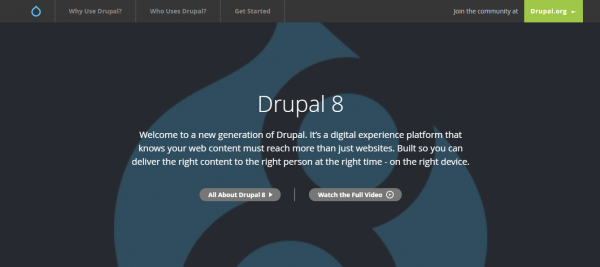
As a fellow CMS, Drupal is one of WordPress’ fiercest competitors in the market. Similar to WordPress, Drupal is entirely scalable to accommodate users with various needs. It also has a dedicated community that supports the platform with various modules and documentation.
Function-wise, Drupal can fit different types and scales of website. In fact, it’s known to produce large-scale websites for big companies like NBC and Pfizer. Adding to the tons of well-designed themes, you’ll get to build a robust, professional-looking website.
As a CMS, Drupal also has flexible taxonomies that allow you to create and organize content sections easily. Websites with complex hierarchies will find this ability incredibly useful.
The Pros
Drupal supports network integration that allows you to connect and collaborate with visitors. Additionally, it has an advanced administrator controls capable of setting up user accounts and user permissions. Both features are ideal for creating community platform sites.
The Cons
The biggest downside of most CMS is their tendency to have a steep learning curve, and Drupal is no exception. Almost every process that happens in it requires basic coding skills. Also, newbies might find its interface less intuitive as it was initially created for web professionals.
2. Joomla!
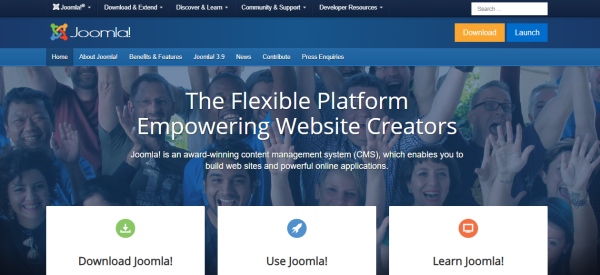
Here’s yet another CSM that rivals WordPress. Joomla is an open-source, community-driven platform that allows users to share information without worrying about licensing fees. Accordingly, there’s a ton of support available to help newbies get started.
If you want to launch an online store, Joomla can help you with that. It has several extensions capable of supporting ecommerce on top of other functionalities that your site might need.
Additionally, Joomla has an easy-to-use content management tool that can assist users with no previous technical experience. Despite its ease of use, the tool doesn’t lack functions as it’s more than capable of satisfying professional developers.
The Pros
Compared to Drupal, Joomla is much easier to understand by newbies. The installation process is quite straightforward, and there are over 4000 templates available to ease the website building process. The content management tool is also intuitive, thus making the editing process easier and more flexible.
The Cons
While Joomla has plenty of plugins, its marketplace is smaller compared to WordPress. Consequently, you might find it challenging to find function-specific plugins. Additionally, compatibility issues may occur and require PHP knowledge to fix.
3. Wix

If you don’t want to deal with technicalities of the website building process, Wix is definitely worth checking out. With a free plan, you can opt for using Wix’s drag-and-drop website builder tool to design your dream website without using a single line of code.
Not feeling confident with your designing skills? Wix’s artificial design intelligence (Wix ADI) is ready to help. The AI will ask several questions related to your preference and the site’s intended functionality, then use your answers to create a website for you.
One of Wix’s biggest strengths lies in its theme collection. There are over 300 professionally designed themes available for free. Added to the various features in the App Market, you can build a niche-based website with the proper look easily.
The Pros
Wix’s website builder tool is easy enough to operate so newbies are unlikely to encounter any difficulties during the website building process. In case you want to make advanced modifications on the interface, you can add JavaScript code through the Corvid development platform.
The Cons
While Wix offers a free plan, it includes ads which can be distracting and obstructive to your site’s aesthetic value. Wix also doesn’t allow you to transfer the site to another platform, so you might want to reconsider another option if you’re planning on moving out in the future.
4. Squarespace

Similar to Wix, Squarespace is a closed source website builder platform that prides itself for having professionally designed themes. The platform has a wide selection of both free and premium themes that are divided into 16 categories based on their niche and functionality.
If you’re constantly on the move, you can take advantage of the Squarespace Commerce App to modify and manage your site on-the-go. The app also provides access to customer support, so you can communicate with the Squarespace support team wherever and whenever needed.
Squarespace is also more than capable of accommodating ecommerce sites. Whether you sell goods, services, or subscriptions, the platform has all the tools to facilitate the entire transaction process. To top it off, you can run your business from a mobile device through the previously mentioned mobile app.
The Pros
As Squarespace pays special attention to site appearance, you’ll find a lot of design-related features and tools that enhance this aspect. This includes having plenty of premium-looking themes and access to royalty-free stock images from the Unsplash and Getty Images galleries.
The Cons
Despite having robust features and tools, you need to buy Squarespace’s premium plan as the platform doesn’t provide a free option. Unfortunately, Squarespace is pricier compared to other website builder platforms. So, users with a tight budget will be put at a disadvantage.
5. Weebly

Despite being a closed source website builder platform, Weebly allows you to use themes created by third-party developers. This flexibility compensates Weebly’s lack of available theme options compared to competitors like Squarespace and Wix.
Thanks to the drag-and-drop features, Weebly’s website builder tool is easy enough to use even by newbies with little to no technical knowledge. In case you want to make advanced modifications, Weebly supports custom HTML, CSS, and JavaScript code integration.
What’s interesting is that Weebly provides a customized onboarding process based on the type of the site instead of a one-size-fits-all tutorial. Whether you want to build an ecommerce store or a blog site, the platform will point out all the right tools to help you get started.
The Pros
Weebly’s commerce tools support every business process that an online store has to have: transactions, shipping, and inventory management. It also has plenty of payment gateways and payment-related features like a coupon system and tax calculator to ease the transaction process.
The Cons
Despite incorporating drag-and-drop features in its website builder tool, it’s hard to make advanced modifications unless you have the programming skills to add your own code. Consequently, newbies will have to make do with the available tools, which don’t offer much.
6. Jimdo
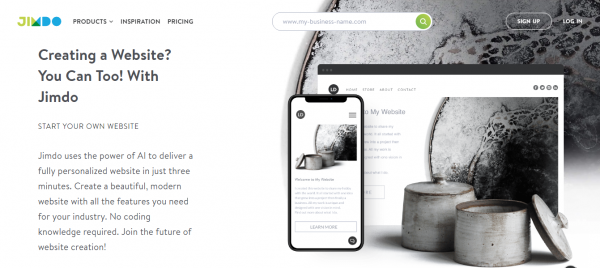
Just like Wix, Jimdo also has an ADI called Jimdo Dolphin capable of building a website based on your preference. The feature can save you time by not building the site from scratch as it allows you to modify or add new elements on the ADI-generated site with a few simple clicks.
Jimdo also has your back in the SEO department. Its back end customization feature gives you access to various SEO-related site elements like meta titles, descriptions, custom URLs, and alt texts. If you know anything about SEO optimization, you know that this feature is a game-changer.
Need additional features? There are 50 free plugins provided by POWr available for use. The plugin functionality ranges from social media-related features like platform integration and review embedding to ecommerce enhancements like a form builder and pricing table.
The Pros
While some platforms lock their best features behind paywalls, Jimdo gives them for free right off the bat. The free tools provide most of the essential functionalities a website needs for blogging, ecommerce, and SEO optimization.
Thus, you get to build a multi-functional site and test the platform’s basic capabilities without having to commit to a premium plan from the get-go.
The Cons
While you can perform manual search engine optimization using the back end customization feature, you cannot add SEO plugins to your site. Consequently, you will have to rely on SEO guides and third-party platforms like Pingdom and Yoast to evaluate and improve your SEO performance.
7. Medium

If you want to build a blog site, Medium is worth considering. As one of the best community blogging platforms, it helps you focus on producing high-quality content. Thus, you only need to signup to Medium and let it deal with the technicalities behind your site.
As Medium is a community-based platform, you’re guaranteed to get much more exposure from the get-go. Aside from having a broad audience, Medium provides backlinks and social media sharing elements to boost traffic even further, which is good for SEO, but sadly technically the improvements will be towards medium as a platform, not to your own site.
Medium makes sure that your content is well-taken care of by providing a robust CMS. Not only will you find it easy to manage your posts, and offer a great user experience for readers as Medium’s content display arrangement ensures great readability.
The Pros
The biggest advantage of using Medium to publish your writing is the amount of exposure you can get without doing all the promotion yourself. As long as you can create high-quality content, your site will gain traction from the Medium community on its own.
The Cons
Contrary to WordPress, Medium is a one-size-fits-all platform. While it provides everything you need to launch a blog, you have no control over your blog’s elements, including the functionality, SEO, and analytics. In short, you’re stuck with what Medium gives you.
8. Ghost
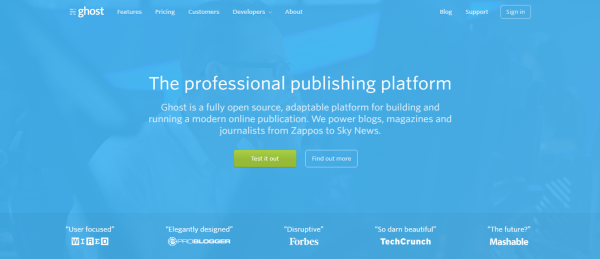
Similar to Medium, Ghost also specializes in blog sites. However, Ghost’s way of working is more similar to WordPress than Medium. As a NodeJS-based open-source platform, Ghost allows third-party service integration and theme customization through Zapier and Ghost’s Public API.
Ghost’s feature-rich editor allows you to not only edit and format your post easily but also add dynamic blocks to insert videos, images, and other embeds. Additionally, the platform supports multiple collaborators and role distributions to make large-scale content production easier.
You can also categorize your content, build custom homepages, and add multi-language content among other features thanks to its robust content management system. There are also built-in SEO features like XML Sitemaps, metadata, and permalinks available for immediate use.
The Pros
Ghost uses the Markdown editor that allows you to customize the whole page without going through individual blocks first. While it works slightly different than an HTML editor, it is visually appealing and beginner-friendly.
The Cons
While you have access to various plugins courtesy of Zapier and Ghost Public API, Ghost is only suitable for blog sites. If you want to build other another type of website, you might want to look for alternatives.
9. Shopify
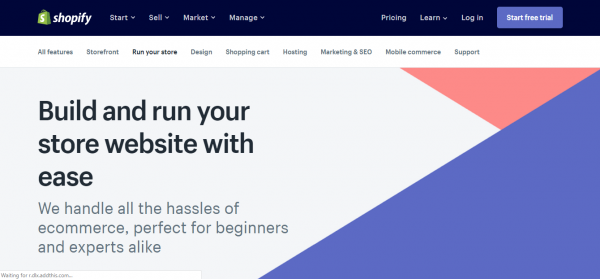
Shopify’s robust ecommerce tools and features make it perfect for assisting you in launching an online store. The platform’s features cover all business processes that most online stores go through such as order placement, payment protection, and shipping monitoring.
The platform also gives access to various insights regarding your store sales and customer profile. Thus, you get to identify any bottlenecks that might hinder your business and address them immediately. Knowing your customers will also help improve your marketing strategy.
Despite focusing more on the business side, Shopify provides a blogging space where you can publish business-related posts to boost your SEO and build your community.
The Pros
If you have a physical store, you can use the Shopify POS app to support your transactions. The app is compatible with various business hardware like barcode scanners and receipt printers. You can also integrate your site with various online channels like Amazon and eBay.
The Cons
While Shopify provides various robust ecommerce tools, there’s no way to extend your site’s functionality with third-party plugins. This limitation also prevents you from optimizing your SEO or improving blogging functionality. Bottom line, Shopify isn’t ideal for non-ecommerce sites.
10. BigCommerce

True to its name, BigCommerce is yet another ecommerce platform capable of launching your online store. Due to being a long-time player in the ecommerce industry, BigCommerce has expanded its network to accommodate customers from over 150 countries.
Functionality-wise, BigCommerce offers a wide range of essentials ecommerce features like discount vouchers, real-time shipping rate calculators of established carriers, product reviews, and email marketing service integration. These features are available without any additional installation.
As ecommerce sites usually incorporate lots of product images, your website might slow down while your store is growing. BigCommerce tackles this issue by collaborating with the Akamai Image Manager to help your site load faster on all browsers and, consequently, improve your SEO.
The Pros
Security is an essential aspect of every ecommerce site. Thus, BigCommerce protects its checkout system with a multi-layered security approach including PCI compliance. You can also buy additional security apps from BigCommerce’s partners through the Apps & Integrations page.
The Cons
If you want to have a premium-looking theme, be ready to spend some extra money. BigCommerce only offers ten free themes, all of which have standard features. The premium themes, which are categorized based on functionality and industry, cost from $145 to $235.
Choose What’s Best for You
WordPress might be a popular content management system, but it’s not for everyone. Like any other product out there, there’s bound to be several cons that discourage you from choosing WordPress to publish your site.
Luckily for you, there are plenty of alternatives for you to choose from. Here are our top 10 WordPress alternatives worth considering:
- Drupal — supports collaborative work and user access distribution
- Joomla! — has intuitive content management tools
- Wix — a beginner-friendly website builder with tons of premium themes
- Squarespace — allows managing the site and reaching out to customer support on-the-go
- Weebly — drag-and-drop website builder tool with custom code integration
- Jimdo — grants back end customization great for SEO optimization
- Medium — a blogging platform with a broad audience
- Ghost — uses a visually appealing and beginners-friendly Markdown editor
- Shopify — supports multiple ecommerce channel integration.
- BigCommerce — supports transactions from over 150 countries.
Each platform has its strengths and weaknesses. Your needs will most likely differ from those of other people. So, there’s no telling which platform is the best. Thus, it’s best to identify your goal first and go through the options from there.

